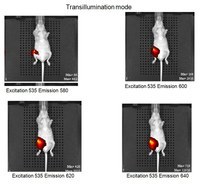Bioluminescence Imaging
 |  |
|---|

Biospace Lab Photon Imager is a dedicated low light level in vivo optical modality for bioluminescent and fluorescent imaging. Comparing to other bioluminescent/fluorescent systems, the Photon Imager has two unique features, making it an extremely useful device for investigators who are interested in high-throughput studies as well as absolute and kinetic quantification of their experimental therapy. Not only that the Photon Imager captures absolute photon outputs of a fluorescent or bioluminescent marker, the patented imaging technology allows investigators to record real-time physiological activities and kinetics information of an experimented treatment as indicated by the light emission gradients over time.
In order to achieve low-light sensitivities, the Photon Imager is equipped with a third generation Gallium Arsenide PhotoCathode (GAPC) dual multi channel plate intensifier tube. The GAPC intensifier tube amplifies the low-light bioluminescent and fluorescent photons to a factor of approximately 105 and the amplified signals are then sent to a CCD chip to be analyzed. The photon Imager has two optional field of views, varying from the highest (50 µm) to the lowest magnification (200 µm). The photon scanning system is encased in a light tight shell to ensure that no fewer than 30 incident photons interact with the camera per second. For subject maintenance during acquisition, the Photon Imager has external port for isoflurane inlet and outlet and a heat-plate embedded platform for re-establishment of the normative physiological state of the subject.
Due to the Photon Imager's ability to acquire real-time and kinetic images from light emission from bioluminescent and fluorescent biomarkers, this optical modality provides unique opportunities to measure in vivo biological activities in real-time at a rate of 25 frames per second. With an additional module, a group of investigators was able to image calcium utilization in awake mice as well as epileptic mice as these biological events occurred in the imager platform. Another group of investigators was able to use the Photon Imager to acquire protein degradation kinetic of HIF-1alpha, a crucial protein for human oncogenesis. If a probe transduction or construction is optimized, kinetic modeling of a compound of interest or system of interest will be a possibility.
This current system will be later upgraded to Biospace Lab's newest dynamic in vivio optical system called Optima (http://www.biospacelab.com/index.php).